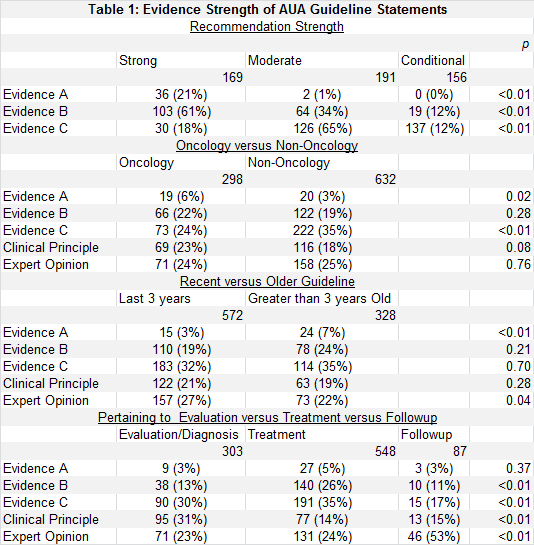Back
Poster, Podium & Video Sessions
Moderated Poster
MP13: Health Services Research: Practice Patterns, Quality of Life and Shared Decision Making I
MP13-16: The AUA Guidelines: An Evaluation of Evidence Grade Backing Statements
Friday, May 13, 2022
2:45 PM – 4:00 PM
Location: Room 228
Chris Du*, Kuemin Hwang, John Hill, Howard L. Adler, Stony Brook, NY
.jpg)
Chris Du, MD
Stony Brook University Hospital
Poster Presenter(s)
Introduction: As part of its mission to provide the highest standards of clinical care, the American Urological Association (AUA) publishes guidelines on numerous urologic topics to assist clinical decision making. These guidelines are written after a systematic review and meta-analysis of research and advancements in the topic of interest. We sought to evaluate the caliber of evidence used establish the currently available AUA guidelines.
Methods: All AUA guideline statements on the AUA website were reviewed for their level of evidence and recommendation strength. Statistical analysis was performed to identify any differences between oncological and non-oncological topics, newer versus older guidelines, and statement pertinence to diagnosis, treatment, and followup. All statistical analysis was performed via SPSS statistical software.
Results: We identified guidelines available for 32 urologic topics. One guideline did not offer levels of evidence and was excluded.
938 statements were analyzed for this study. 39 (4.2%) were backed by Grade A evidence, 188 (20%) Grade B, 297 (31.6%) Grade C, 185 (19.7%) Clinical Principle, and 230 (24.5%) Expert Opinion. Of the recommendations made, 169 Strong, 191 Moderate, and 156 Conditional were made. There was a statistically significant association of Grade A (36, p<0.01) and B (103, p<0.01) evidence backing Strong Recommendations. There was a significant association of oncology guidelines (6% vs 3%, p=0.021) having more grade A evidence and less Grade C Evidence (24% vs 35%, p=0.002). Guidelines published in the last 3 years vs. older guidelines had less Grade A Evidence (3% vs 7%, p<0.01) and more Expert Opinion backing (27% vs 22%, p=0.038). Statements pertaining to diagnosis and evaluation were more likely backed by Clinical Principle (31% vs 14% vs 15%, p<0.01), while treatment statements were backed by B (26% vs 13% vs 11%, p<0.01) and C (35% vs 30% vs 17%, p<0.01) grade evidence, and followup statements by Expert Opinion (53% vs 23% vs 24%, p<0.01).
Conclusions: The majority of evidence for the AUA guidelines is not high grade. While topics such as oncology are more likely to have higher grade evidence, there appears to be a recent trend toward weaker evidence statements as well as less evidence backing diagnosis and followup statements. More research is needed to modify and enhance the guidelines to deliver evidence based urologic care.
Source of Funding: none

Methods: All AUA guideline statements on the AUA website were reviewed for their level of evidence and recommendation strength. Statistical analysis was performed to identify any differences between oncological and non-oncological topics, newer versus older guidelines, and statement pertinence to diagnosis, treatment, and followup. All statistical analysis was performed via SPSS statistical software.
Results: We identified guidelines available for 32 urologic topics. One guideline did not offer levels of evidence and was excluded.
938 statements were analyzed for this study. 39 (4.2%) were backed by Grade A evidence, 188 (20%) Grade B, 297 (31.6%) Grade C, 185 (19.7%) Clinical Principle, and 230 (24.5%) Expert Opinion. Of the recommendations made, 169 Strong, 191 Moderate, and 156 Conditional were made. There was a statistically significant association of Grade A (36, p<0.01) and B (103, p<0.01) evidence backing Strong Recommendations. There was a significant association of oncology guidelines (6% vs 3%, p=0.021) having more grade A evidence and less Grade C Evidence (24% vs 35%, p=0.002). Guidelines published in the last 3 years vs. older guidelines had less Grade A Evidence (3% vs 7%, p<0.01) and more Expert Opinion backing (27% vs 22%, p=0.038). Statements pertaining to diagnosis and evaluation were more likely backed by Clinical Principle (31% vs 14% vs 15%, p<0.01), while treatment statements were backed by B (26% vs 13% vs 11%, p<0.01) and C (35% vs 30% vs 17%, p<0.01) grade evidence, and followup statements by Expert Opinion (53% vs 23% vs 24%, p<0.01).
Conclusions: The majority of evidence for the AUA guidelines is not high grade. While topics such as oncology are more likely to have higher grade evidence, there appears to be a recent trend toward weaker evidence statements as well as less evidence backing diagnosis and followup statements. More research is needed to modify and enhance the guidelines to deliver evidence based urologic care.
Source of Funding: none


.jpg)
.jpg)